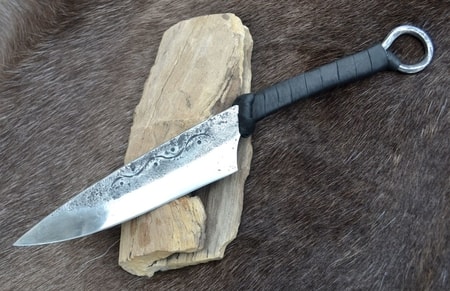- Joined
- Oct 25, 2003
- Messages
- 703
The ancient battlefields would have been a sweating, heaving mob at times. To think you would never be knocked off your feet, or overwhelmed by pressing bodies would be foolish indeed. That would be like a modern quarterback who thinks he'll never be knocked down.
All of a sudden, your sword, axe, shield, and spear would be useless. Your only hope is that the press of bodies will keep the enemy from stabbing down at you. Obviously, you need too clear a space and get up.
What would save your life?
There also would be hard imagining that, in a shield wall, men might specialize in crawling under and attacking from the ground.
Here's my idea and why. Let's see who agrees, or disagrees...

1) I pick a knife, because a weapon, such as I describe, would have to be kept on the soldier at all times. Preferably hidden.
2) It would be about 9 inches long and single edge. Nine inches is the right size to hide under clothing, any larger is cumbersome. I like to carry a knife front-and-center(under the belly button. Thus, I like a single edge, because I feel safer drawing it.
3) The blade would be broad and tapering, with no parallel lines, like a tooth. Normally, I like thin, stabbing knives, but in this case, I would want a broad blade that has no chance of sticking, It would be a blood letter, designed to go in and out, but also able to slash.
4) It would have a reinforced point, designed to stab through boots and up into knees and groins without breaking.
5) Again, I like the 9 inch length, because this weapon should have a blade equal in length to the handle. Nothing handles as well when rolling and squirming.
6) The knife would have a definite pommel and guard. Because I like my thumb planted, I think a C-shaped handle, much like a falcata. Also the bade shouldn't be sharpened all the way down. How many times have we all heard about people cutting themselves in knife fights, yet we continue to see knives with no quillions. I thought of using a D guard, but some experts have opined that they are not good in close quarters. The enemy can force the D down over your hand and do terrible things to your thumbs. Still, you don't want to lose the knife.
Think of yourself as a wrestler. What kind of weapon do you want?
All of a sudden, your sword, axe, shield, and spear would be useless. Your only hope is that the press of bodies will keep the enemy from stabbing down at you. Obviously, you need too clear a space and get up.
What would save your life?
There also would be hard imagining that, in a shield wall, men might specialize in crawling under and attacking from the ground.
Here's my idea and why. Let's see who agrees, or disagrees...

1) I pick a knife, because a weapon, such as I describe, would have to be kept on the soldier at all times. Preferably hidden.
2) It would be about 9 inches long and single edge. Nine inches is the right size to hide under clothing, any larger is cumbersome. I like to carry a knife front-and-center(under the belly button. Thus, I like a single edge, because I feel safer drawing it.
3) The blade would be broad and tapering, with no parallel lines, like a tooth. Normally, I like thin, stabbing knives, but in this case, I would want a broad blade that has no chance of sticking, It would be a blood letter, designed to go in and out, but also able to slash.
4) It would have a reinforced point, designed to stab through boots and up into knees and groins without breaking.
5) Again, I like the 9 inch length, because this weapon should have a blade equal in length to the handle. Nothing handles as well when rolling and squirming.
6) The knife would have a definite pommel and guard. Because I like my thumb planted, I think a C-shaped handle, much like a falcata. Also the bade shouldn't be sharpened all the way down. How many times have we all heard about people cutting themselves in knife fights, yet we continue to see knives with no quillions. I thought of using a D guard, but some experts have opined that they are not good in close quarters. The enemy can force the D down over your hand and do terrible things to your thumbs. Still, you don't want to lose the knife.
Think of yourself as a wrestler. What kind of weapon do you want?







